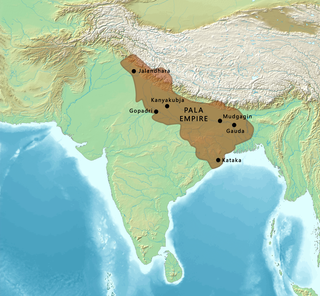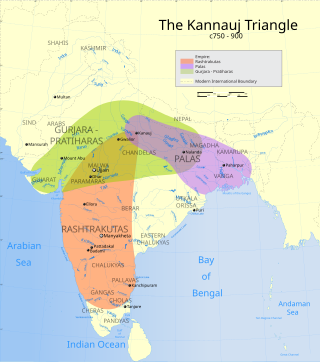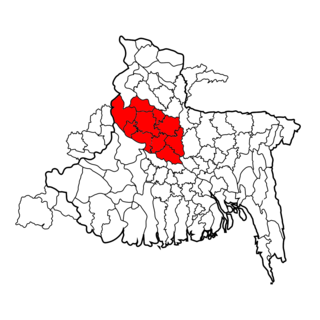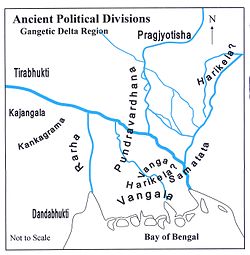
The Gurjara-Pratihara was a dynasty that ruled much of Northern India from the mid-8th to the 11th century. They ruled first at Ujjain and later at Kannauj.

The Pāla Empire was an imperial power during the post-classical period in the Indian subcontinent, which originated in the region of Bengal. It is named after its ruling dynasty, whose rulers bore names ending with the suffix Pāla. The empire was founded with the election of Gopāla as the emperor of Gauda in late eighth century CE. The Pala stronghold was located in Bengal and eastern Bihar, which included the major cities of Gauḍa, Vikramapura, Pāṭaliputra, Monghyr, Somapura, Ramavati (Varendra), Tāmralipta and Jaggadala.

The Sena dynasty was a Hindu dynasty during the early medieval period on the Indian subcontinent, that ruled from Bengal through the 11th and 12th centuries. The empire at its peak covered much of the north-eastern region of the Indian subcontinent. The rulers of the Sena Dynasty traced their origin to the south Indian region of Karnataka.

Bengali Brahmins are the community of Hindu Brahmins, who traditionally reside in the Bengal region of the Indian subcontinent, currently comprising the Indian state of West Bengal and the country of Bangladesh.

The Varman dynasty (350–650) was the first historical dynasty of the Kamarupa kingdom. It was established by Pushyavarman, a contemporary of Samudragupta. The earlier Varmans were subordinates of the Gupta Empire, but as the power of the Guptas waned, Mahendravarman (470–494) performed two horse sacrifices and the status of Kamarupa as an independent state remained unimpaired. As per the Apsad Inscription of Adityasen, Susthivarman was defeated by Mahasengupta on the bank of Lauhitya. The first of the three Kamarupa dynasties, the Varmans were followed by the Mlechchha and then the Pala dynasties.

Vanga was an ancient kingdom and geopolitical division within the Ganges delta in the Indian subcontinent. The kingdom is one of the namesakes of the Bengal region. It was located in southern Bengal, with the core region including the southern part of present-day West Bengal (India) and southwestern Bangladesh. Vanga features prominently in the epics and tales of ancient India as well as in the history of Sri Lanka.

Rarh region is a toponym for an area in the Indian subcontinent that lies between the Chota Nagpur Plateau on the West and the Ganges Delta on the East. Although the boundaries of the region have been defined differently according to various sources throughout history, it is mainly coextensive with the state of West Bengal, also comprising parts of the state of Jharkhand in India. Linguistically, the region is defined with population speaking the Rarhi Bengali local Bengali dialect.

The Kamboja-Pala dynasty ruled parts of Bengal in the 10th to 11th centuries CE, after invading the Palas during the reign of Gopala II. The last Kamboja ruler of the Kamboja-Pala Dynasty Dharmapala was defeated by the south Indian Emperor Rajendra Chola I of the Chola dynasty in the 11th century.

Bikrampur was a pargana situated 19 kilometres (12 mi) south of Dhaka, the modern capital city of Bangladesh. In the present day, it is known as the Munshiganj District of Bangladesh. It is a historic region in Bengal and was a part of the Bhawal Estate.
Devapala was the most powerful ruler of the Pala Empire of Bengal region in the Indian Subcontinent. He was the third king in the line, and had succeeded his father Dharamapala. Devapala expanded the frontiers of the empire by conquering the present-day Assam and Orissa. The Pala inscriptions also credit him with several other victories, but these claims are thought to be exaggerated.
Gopala was the founder of the Pala dynasty of Bihar and Bengal regions of the Indian Subcontinent. The last morpheme of his name Pala means "protector" and was used as an ending for the names of all the Pala monarchs. Pala does not suggest or indicate any ethnic or caste considerations of the Pala dynasty. He came to power in later half of eighth century AD in Gaur/Gaud after being elected by a group of regional chieftains.

Dharmapala was the second ruler of the Pala Empire of Bengal region in the Indian subcontinent. He was the son and successor of Gopala, the founder of the Pala Dynasty. Dharmapala was mentioned as the great king of Vangala in the Nesari plates of Rashtrakuta dynasty. He greatly expanded the boundaries of the empire, and made the Palas a dominant power in the northern and eastern India.
Rajyapala or Kamboja-Vamsa-Tilaka was the founder of the Kamboja Pala dynasty of Bengal. This dynasty had ruled over northern and western Bengal. Four rulers of this dynasty are known who ruled, either over north-west Bengal or parts thereof, from second half of tenth century to the first quarter of the 11th century. The last known king of Kamboja Pala dynasty was Dharmapala, who was the ruler in Dandabhukti division, during the first quarter of the 11th century.
Dharmapala Kamboja was probably the last ruler of Kamboja Pala dynasty of Bengal. He ruled Dandabhukti-mandala in Vardhamana-bhukti in the first quarter of eleventh century and was contemporary of Rajendra Chola of Chola dynasty of Deccan.
Vigrahapala III was the successor to the Pala king Nayapala in the Bengal region of the Indian subcontinent, and twelfth ruler of the Pala line reigning for 15 years. He was succeeded by Mahipala II.

Samataṭa was an ancient geopolitical division of Bengal in the eastern Indian subcontinent. The Greco-Roman account of Sounagoura is linked to the kingdom of Samatata. Its territory corresponded to much of present-day eastern Bangladesh and parts of the Rakhine State of Myanmar. The area covers the trans-Meghna part of the Bengal delta. It was a center of Buddhist civilisation before the resurgence of Hinduism and Muslim conquest in the region.

Kamarupa – Late to end period was a period of Kamarupa kingdom from founding of Pala Dynasty by Brahma Pala to last ruler of dynasty Jaya Pala.

The Varendra rebellion was the revolt against King Mahipala II led by Kaivarta chieftain Divya (Dibyak), a feudal lord of Northern Bengal. The Kaivartas were able to capture Varendra by this rebellion. The revolt might have been the first peasant revolt in Indian history. However, the first phase of the revolt would more appropriately be described as a rebellion of feudal lords(Samantas), who would have mobilized the peasants, and the last phase of the revolt was a spontaneous mass uprising.
Lakshmikarna, also known as Karna, was a ruler of the Kalachuri dynasty of Tripuri in central India. His kingdom was centered around the Chedi or Dahala region in present-day Madhya Pradesh.













